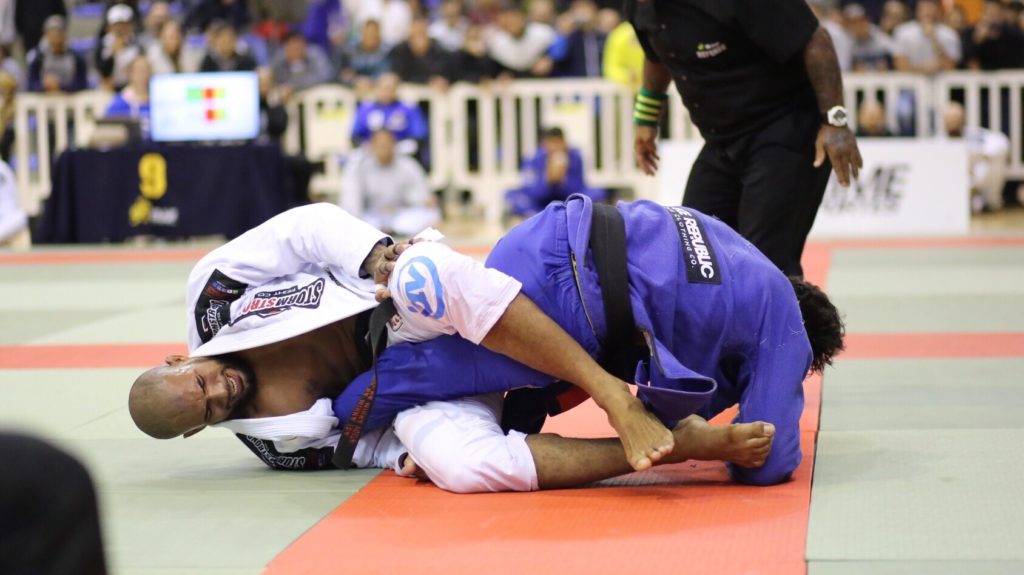Guest post by Evolve MMA, Asia’s premier championship brand for martial arts. It has the most number of World Champions on the planet. Named as the #1 ranked martial arts organization in Asia by CNN, Yahoo! Sports, FOX Sports, Evolve MMA is the top rated BJJ gym in Singapore.
While most of the lower body submissions are illegal for competitors under the brown and black belts, the IBJJF does permit variations of the ankle lock at the lower belt levels. While engaging the lower body can be risky, as you do open yourself up to potentially violating the rules, if you practice each of these moves in accordance with the IBJJF’s rules, they will become a formidable weapon in your arsenal that you can use throughout your IBJJF competition career.
Each of these submissions is a variation of an ankle lock, so while they appear different, the mechanics are identical. For all ankle locks, the key to effectively submitting your opponent is to roll their ankle, not hyperextend it. Keep this in mind as you practice, making sure that you are twisting their foot and not just trying to pull it.
1) The Ankle Lock
While the ankle lock is often identified under different names — such as “the foot lock,” or “the Achilles lock” — regardless of how it is named, the ankle lock is an incredibly powerful submission hold that should be developed by all Brazilian Jiu-Jitsu (BJJ) practitioners, even the lower belts. Not only will developing a powerful ankle lock provide a grappler the ability to defeat opponents whose guard they cannot pass, but it offers additional value as well: opponents who are fearful of being submitted by an ankle lock will often give up guard passes while they try to hide their feet. And from the bottom, a good ankle lock will allow a guard player to supplement their sweeps and upper body submissions with a lower-body attack.
The key to having an IBJJF-legal ankle lock that is still substantially powerful is to focus on bending the opponent’s ankle, not their knee. The first step to attacking the ankle lock is to overwrap the opponent’s ankle in your armpit; the top of their foot should be on your lat muscles, while the “blade” of your forearm is around their Achilles tendon. Make sure you have a tight grip by pushing your hand all the way across to your pectoral muscle. Once the grip has been achieved, you can fall back to the mat, placing your outside foot on their hip bone as your inside knee moves to your foot to connect. Now, with the grip secure, roll your elbow back behind you, bending your opponent’s ankle. Using the foot you have on your opponent’s hip, drive backward, rolling their ankle and forcing your partner to submit.
2) The Cross Body Ankle Lock
While the body positioning of the cross body ankle lock is different from its standard counterpart, the breaking mechanics are exactly the same; this is a good reason to perfect the standard ankle lock, as a deep understanding of how to submit with the ankle lock will assist a grappler in developing a formidable cross body ankle lock.
The principle difference between the cross body ankle lock and the ankle lock is which arm you will use to wrap your opponent’s leg: while the ankle lock requires you to overwrap your opponent’s left leg under your right armpit, the cross body ankle lock will be initiated when you wrap your opponent’s right leg under your right armpit. The best time to do this is when your opponent’s leg is across your body, such as just after completing a leg drag.
Say you have just initiated a leg drag pass against your opponent, but it wasn’t entirely successful. After dragging your opponent’s right leg across your body, they are able to frame away and bring their shin back in front of you. From here, wrap your right arm over your opponent’s right leg. Slide your grip down so that the top of their foot is on the back of your lat, just like with the standard ankle lock. Now, fall to your left hip and hand as you slide your right knee on top of your opponent’s right knee, using it to push their knee to the floor. With a slight twist of your upper body, and by driving away from your opponent, you can force them to tap.
3) The Tripod Ankle Lock
Perhaps the most powerful of our three IBJJF-legal foot locks, the tripod ankle lock is simultaneously a strong breaking position that is very hard to defend. You will start the tripod ankle lock the same way you did the classic ankle lock, by over-wrapping your opponent’s left leg with your right arm. But instead of falling backward and potentially giving the top position to your opponent, you will now go forward, driving your left knee across your opponent’s hip and placing it on the mat. At the same time, your left arm should be reaching to the mat to brace your descent.
The key to submitting your opponent with the tripod ankle lock is to extend your opponent’s leg by getting as far away from them as possible: use your free hand, your left in this case, to pull yourself across the mat and away from your opponent’s body. Once their leg is at an almost full extension, drop your hips to the mat as you roll your right elbow behind you. This will bend your opponent’s ankle, forcing them to tap.
Not only do each of these three submissions offer you fun and unique ways to submit your opponent, but they are incredibly effective. At the lower belt levels, most competitors have yet to include the realm of leg locks into their repertoire, making them naive and vulnerable to each of these submissions. Make sure you practice frequently, as these are three submissions that will help you greatly!
Leap into the world of LEG ATTACKS with both feet with IBJJF Legal Leg Attack Secrets from Dean Lister.
- Dean Lister is the GODFATHER of the modern leg game and has been submitting the biggest BJJ names on the planet for twenty-five years.
- Let Dean help you navigate THOSE TRICKY IBJJF rules and LEAPFROG over your competition by knowing LEG ATTACKS and DEFENSES.


















